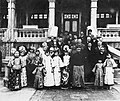Zhang Garden
History
In 1912, Qing official Zhang Biao, settled in the Japanese Concession in Tianijn and built a three-story mansion in a Western Neoclassical-inspired style on Miyajima Street (now No.59 Anshan Road). By the 1920s he cooperated with a businessman to create a restaurant, theater, and an open-air cinema at Zhangyuan. Four bungalows on the right side of the park for Puyi's entourage were also later built. After Puyi left Tianjin, Zhang Biao's son sold the Zhang Garden to the Japanese military in the 1930s and it was subsequently demolished and rebuilt. It was then used as a garrison station for the Japanese Concession police. After World War 2 it was used as a garrison for the Chinese Kuomintang Army in 1946 during the Chinese Civil War. It has since been used as a theatre and a library.
Gallery
-
Zhang Garden exterior
-
Zhang Garden building and exterior
-
The rock garden in the Zhang Garden
-
Sun Yat-Sen at the Zhang Garden, 1924
-
Puyi and Wanrong in 1927 at the Zhang Garden
-
Empress Consort Wanrong on the balcony of the Zhang Garden mansion
-
Empress Consort Wanrong in the Zhang Garden with her dog
-
Puyi in the Zhang Garden
-
Puyi in the Zhang Garden during winter
-
Zhang Garden exterior
-
Zhang Garden after being rebuilt
-
Two interior spaces within the Zhang Garden
See also
References
- ^ The Last Emperor and His Five Wives. p. 39.
- ^ "张园 - 《中国大百科全书》第三版网络版". www.zgbk.com. Retrieved 2022-11-08.
- ^ "文史|天津张园的百年风雨_腾讯新闻". new.qq.com. Retrieved 2022-11-08.
- ^ "The original owner of Zhang". www.tjwh.gov.cn. 2008-12-03. Retrieved 2022-11-07.
- ^ Palace Museum, Beijing. 故宫藏影 西洋镜里的宫廷人物. p. 247.












![Two interior spaces within the Zhang Garden [5]](http://upload.wikimedia.org/wikipedia/commons/thumb/7/79/Two_interior_spaces_within_the_Zhang_Garden.png/79px-Two_interior_spaces_within_the_Zhang_Garden.png)